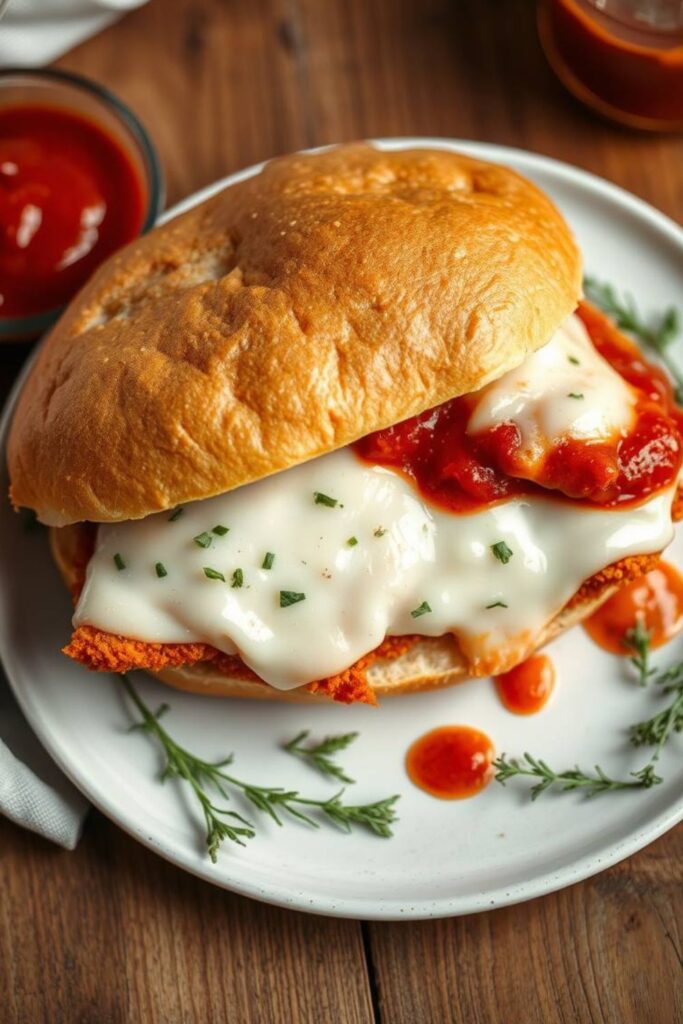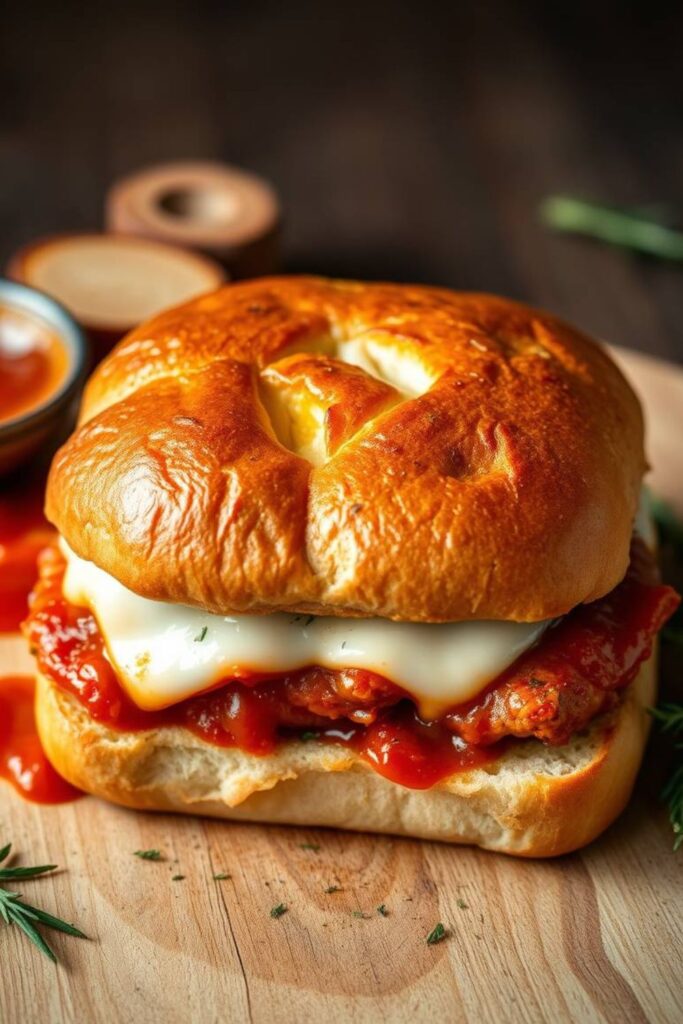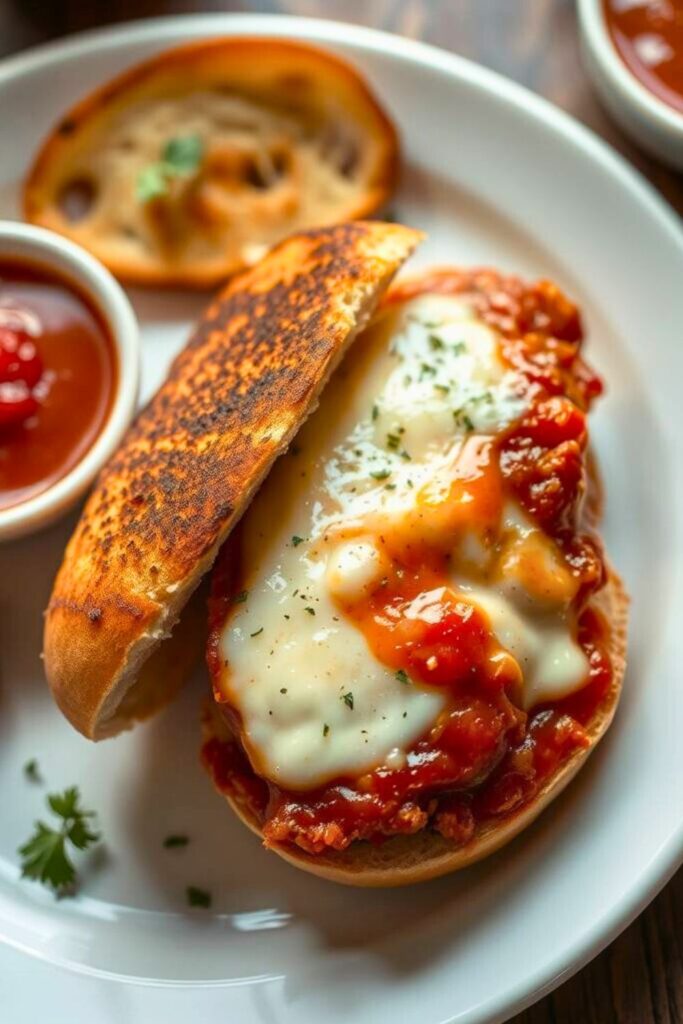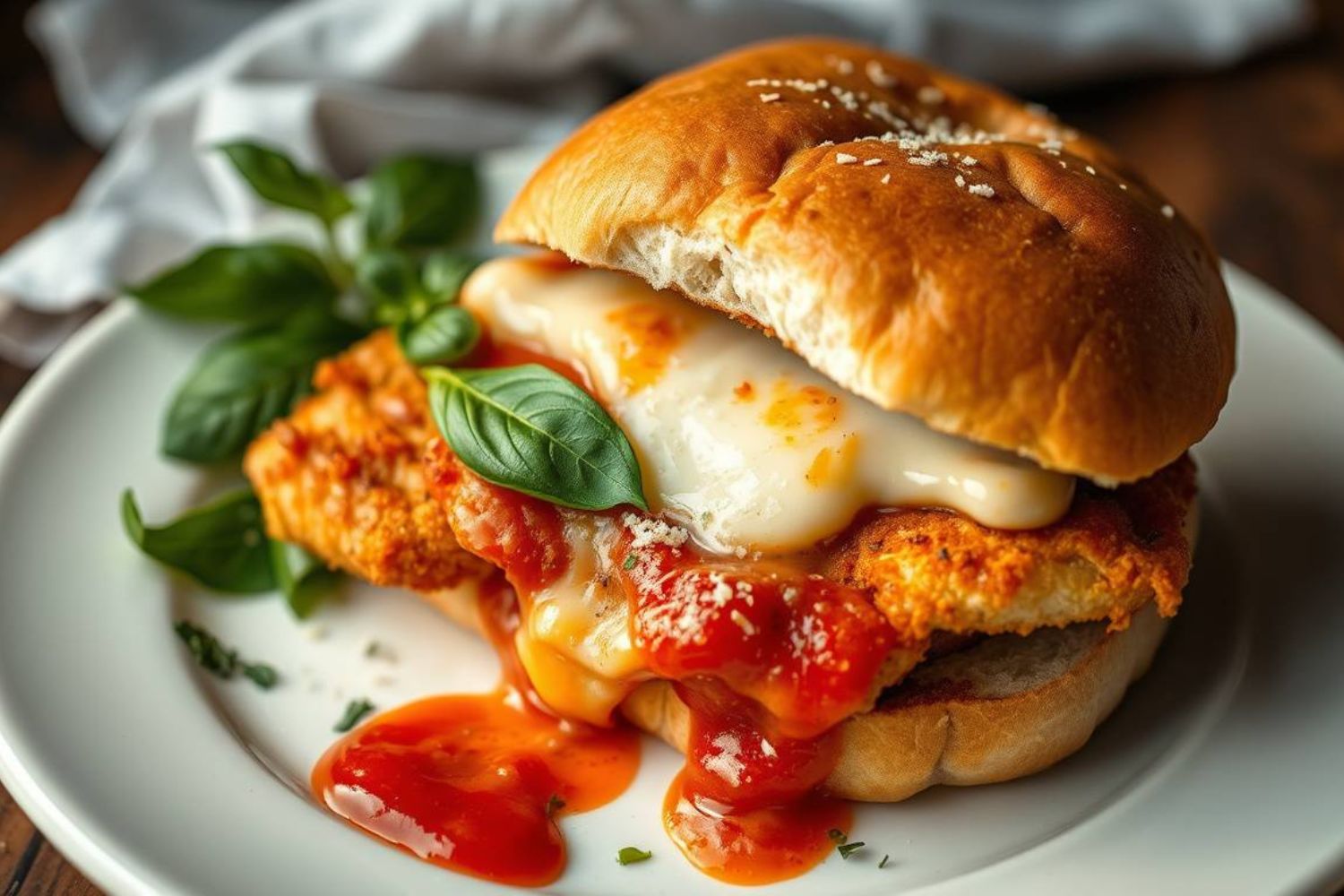Here’s the truth about most chicken parmesan sandwiches: they’re disappointing. Soggy bread. Rubbery chicken. Cheese that slides right off. You bite into what should be comfort food perfection and get… meh.
I used to accept mediocre chicken parm sandwiches as just part of life. Then my Italian neighbor, Mrs. DiMarco, watched me struggle with another failed attempt and shook her head. “You’re doing it all wrong, cara mia.”
What she taught me that afternoon changed everything. This isn’t just another chicken parmesan sandwich recipe. It’s the technique that creates restaurant quality results in your home kitchen. We’re talking golden, crispy coating that stays crunchy. Juicy chicken that never dries out. Cheese that melts into perfect, stretchy heaven.
The secret? It’s not about fancy ingredients or expensive equipment. It’s about understanding three simple techniques that most people skip. Master these, and you’ll never settle for a disappointing chicken parm sandwich again.
Ready to make the sandwich that’ll have your family asking for seconds before they’ve finished their first bite?
Chicken Parmesan Sandwich Recipe: Mastering the Ingredients

The Star Players You’ll Need
Gather these ingredients in the order you’ll use them:
For the Chicken:
- 2 large boneless, skinless chicken breasts (about 1.5 pounds)
- 1 cup all purpose flour
- 2 large eggs, beaten
- 2 cups panko breadcrumbs
- 1/2 cup freshly grated Parmesan cheese
- 1 teaspoon garlic powder
- 1 teaspoon Italian seasoning
- 1/2 teaspoon salt
- 1/4 teaspoon black pepper
- Vegetable oil for frying (about 1 cup)
For Assembly:
- 4 fresh ciabatta or sub rolls
- 1 1/2 cups marinara sauce (homemade or quality jarred)
- 8 oz fresh mozzarella, sliced thick
- 1/4 cup fresh basil leaves
- 2 tablespoons butter
- 1 clove garlic, minced
Smart Swaps That Work
Can’t find panko? Use regular breadcrumbs but toast them first. Living gluten free? Mix almond flour with crushed pork rinds for incredible crispy coating.
Fresh mozzarella costs more low moisture mozzarella melts beautifully too. No ciabatta at your store? Any crusty roll works. Avoid soft sandwich bread that gets soggy.
Here’s what most people don’t know: chicken type matters. Those thin sliced cutlets from stores often dry out. Buy thick breasts and pound them yourself. You control thickness, and they stay juicier.
This simple swap transforms any chicken parmesan sandwich recipe from mediocre to memorable. The difference between store bought cutlets and properly prepared chicken is like night and day.
Mastering the Perfect Recipe Technique
Prep Work That Pays Off
Set up your breading station with three shallow dishes. Put flour in one, beaten eggs in the second, panko Parmesan mixture in the third.
Slice chicken breasts horizontally to create thinner cutlets. Make them about 1/2 inch thick. Don’t go thinner or they’ll dry out. Place them between plastic wrap and pound gently with a meat mallet. You want even thickness, not pancake flat chicken.
Season both sides with salt and pepper. Let them sit for 15 minutes while you prep everything else. This step helps seasoning penetrate and draws out excess moisture.
The Double Dredge Secret
This technique separates good from great. Dredge each cutlet in flour, shake off excess, dip in beaten egg, then coat thoroughly with panko mixture. Here’s the magic part let them rest on a wire rack for 10 minutes.
Now comes round two. Dip back in egg, then coat again with breadcrumbs. This double coating creates layers that puff and crisp into restaurant quality crunch.
Frying Like a Pro
Heat your oil to 350°F in a heavy skillet. Use about 1/2 inch depth. Don’t have a thermometer? Drop in a breadcrumb. If it sizzles immediately without burning, you’re golden.
Fry cutlets for 3-4 minutes per side until deep golden brown. They should sound crispy when you tap them with a fork. Transfer to paper towel lined plate, but don’t let them sit too long.
Building the Ultimate Sandwich
While chicken rests, slice your rolls and brush cut sides with garlic butter. Toast them under the broiler until golden. This creates a barrier that prevents soggy bread later.
Warm your marinara sauce with a pinch of oregano and a splash of good olive oil. Spread a generous layer on the bottom half of each roll.
Place hot chicken on top, then layer with thick mozzarella slices. Pop the whole thing under the broiler for 2-3 minutes until cheese melts and starts to bubble. Add fresh basil leaves, top with the other roll half, and try not to devour it before it cools slightly.
The Science Behind Perfect Chicken Parm

Why This Method Works
That double dredging technique creates magic. The first coating creates a base layer that sticks to chicken. The second coating bonds to the first, creating texture layers that stay crispy even under sauce and cheese.
Resting the breaded chicken lets coating set up. It literally glues itself to the meat. Skip this step and you’ll watch your beautiful breading slide right off in the pan.
Oil temperature is crucial too. Too hot and the outside burns before the inside cooks. Too cool and you get greasy, soggy coating instead of satisfying crunch. 350°F is the sweet spot where moisture escapes quickly enough to create steam pockets that make coating puff and crisp.
Traditional Roots Meet Modern Convenience
Chicken Parmesan has Italian American roots dating back to the early 1900s. Italian immigrants adapted their traditional eggplant parmigiana using chicken, which was more available and affordable in America.
The sandwich version evolved from practicality. Who doesn’t want to eat this incredible combination with their hands? By containing it in a roll, you get all those amazing flavors in each bite, plus the bread soaks up those delicious juices.
Modern techniques like panko breadcrumbs create superior texture to traditional fine breadcrumbs. Panko’s flaky structure traps more air, creating lighter, crispier coating that stays crunchy longer.
Making It Restaurant Beautiful
Plating That Impresses
Even though this is handheld food, presentation matters. Cut your sandwiches diagonally to show off those gorgeous layers. The golden chicken, melted cheese, and vibrant sauce create a beautiful cross section.
Serve on warm plates if you’re feeling fancy. A light drizzle of good olive oil around the plate and a sprinkle of fresh Parmesan adds that professional touch.
Perfect Pairings
This rich, satisfying sandwich pairs beautifully with simple sides that won’t compete. A crisp Caesar salad cuts through the richness perfectly. Roasted vegetables like zucchini or bell peppers add color and freshness.
For drinks, think Italian. A good Chianti or Sangiovese complements the tomato and cheese flavors. Not a wine person? Italian sodas or even a cold beer work great. The key is something that cleanses the palate between bites.
Making It Your Own
Once you’ve mastered the basic technique, variations are endless. Add thin prosciutto slices for a salty twist. Try different cheeses provolone, fontina, or even sharp cheddar create completely different flavor profiles.
Spice lovers can add red pepper flakes to the breadcrumb mixture or use spicy marinara. Want to sneak in vegetables? Thin slices of roasted red pepper or sautéed mushrooms layer in beautifully.
Troubleshooting Common Disasters

When Things Go Wrong
Coating falling off during cooking? Your oil probably wasn’t hot enough, or you skipped the resting time. Coating needs those few minutes to set up properly.
Chicken overcooked and dry? This usually happens when cutlets are too thick or oil temperature too low. Thin, even cutlets cook quickly and stay juicy.
Soggy bread is the enemy of great sandwiches. Always toast your rolls first, and don’t assemble too far ahead. If you’re meal prepping, keep components separate and assemble just before eating.
Storage and Reheating Secrets
Leftover fried chicken keeps in the fridge for three days. Reheat in a 400°F oven for best results. The microwave makes breading soggy. You can even freeze the breaded, uncooked cutlets for up to three months. Fry them straight from frozen, adding a minute or two to cooking time.
Marinara sauce actually improves after a day in the fridge as flavors meld. Make a double batch and use it for pasta later in the week.
This chicken parmesan sandwich recipe delivers everything you want in comfort food. That satisfying crunch, melted cheese perfection, and flavors that make you close your eyes and smile. It’s the kind of recipe that becomes a family favorite, requested for birthday dinners and lazy Sunday meals.
What makes this particular chicken parmesan sandwich recipe so special is its foolproof technique. The techniques you’ll learn here apply to so much more than just this sandwich. Master this double dredging method and you’ll make better fried chicken, fish, and even vegetables. Understanding oil temperature and coating science elevates your entire cooking game.
Most importantly, don’t be afraid to make it your own. Great cooks aren’t born knowing these techniques. They learn through practice and experimentation. Start with this foundation, then let your taste buds guide you toward your perfect version.
Frequently Asked Questions
Can I make this chicken parmesan sandwich ahead of time?
You can prep components separately. Bread the chicken and refrigerate up to 24 hours, make sauce 2-3 days ahead, and slice cheese day of. But don’t assemble until ready to eat. The magic happens when hot, crispy chicken meets melted cheese on toasted bread.
What’s the best oil for frying the chicken?
Vegetable oil, canola oil, or peanut oil work best because of their high smoke points and neutral flavors. Avoid olive oil for frying it burns at these temperatures and adds bitter taste. Save the good olive oil for drizzling at the end.
How do I know when the chicken is fully cooked?
Internal temperature should reach 165°F, but don’t rely solely on thermometers with thin cutlets. Properly pounded cutlets cook quickly, 3-4 minutes per side in 350°F oil. Coating should be deep golden brown and sound crispy when tapped with a fork.
Can I bake the chicken instead of frying?
Absolutely! Place breaded cutlets on a wire rack over a baking sheet, spray with cooking oil, and bake at 425°F for 15-20 minutes, flipping once. You won’t get the same deep crunch as frying, but it’s lighter and still delicious.
What if I can’t find panko breadcrumbs?
Regular breadcrumbs work, but toast them lightly in a dry pan first for extra texture. Crushed cornflakes, crushed crackers, or even finely chopped nuts create interesting alternatives. The key is something with texture that’ll crisp up in oil.

Swiftly Captions by Tina Smith — Quick, flavorful food recipes made simple, bringing fresh inspiration to your kitchen every day






